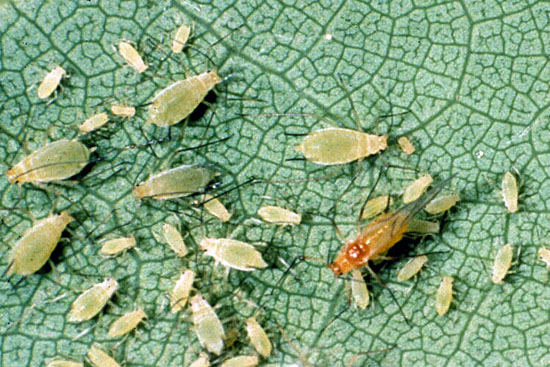Issue 6, May 29, 2012
Aphids
Aphids are more noticeable this spring, particularly on linden and tulip poplar, than they have been for many years. Since the late 1990's when multicolored Asian lady beetles became numerous in the state, aphid numbers have tended to be low.
Aphids are soft-bodied, pear-shaped insects. There are many species of aphids, with adults ranging from pinhead-sized to 1/4 inch long. On trees, most are closer to pinhead-sized, but a common aphid on willow is one of the largest aphid species. Aphid species vary in color, with green being most common. Even a population of one aphid species on a plant may vary in color, apparently depending on factors such as temperature, crowding, and food quality. Aphids tend to have long, spindly legs and long, slender antennae.
Aphids overwinter as eggs, typically on a plant other than the one where they are common during the summer. These eggs hatch into all wingless females that feed on the winter host and give birth to more aphids. Usually after two to three generations on the winter host, the aphids mature into winged adult females that fly to the summer host. On the summer host, up to 30 generations of aphids are produced, all of them being females that give birth to living young without fertilization. Generations are commonly produced weekly, resulting in huge populations building up.
Aphid nymphs in crowded conditions are frequently bumped and jostled by nearby aphids. These aphids will mature into wingless females that give birth to nymphs that will develop wings as they mature into adults, allowing them to fly to new, less infested hosts. Lengthening nights towards the end of the growing season cause females to give birth to nymphs that will mature as winged males and females that must mate to reproduce. The aphids fly to their winter host, where the females lay eggs that overwinter.
Typically, about 2 weeks after they become numerous, aphids that are exposed on the leaves and stems are usually controlled by natural enemies, making insecticide application unnecessary in most cases. Not only does the multicolored Asian lady beetle feed on aphids, but so do other lady beetle species, lacewings, syrphid flies, parasitic wasps, and other insects.

Aphids on tree leaf.
It is more common to control aphids due to their sticky honeydew coating sidewalks, cars, lawn furniture, and other objects under infested trees than to control tree damage. Aphids tend to feed near the tips of branches on the young leaves and stems. This feeding can cause the leaves to wrinkle, curl, twist, or become distorted in other ways. Similarly, young, green stems may curl or twist due to aphid feeding. If needed, contact insecticides such as insecticidal soap, summer spray oil, and pyrethroids are effective. The systemic insecticide, imidacloprid (Merit), is also effective against aphids. (Phil Nixon)
Author:
Phil Nixon